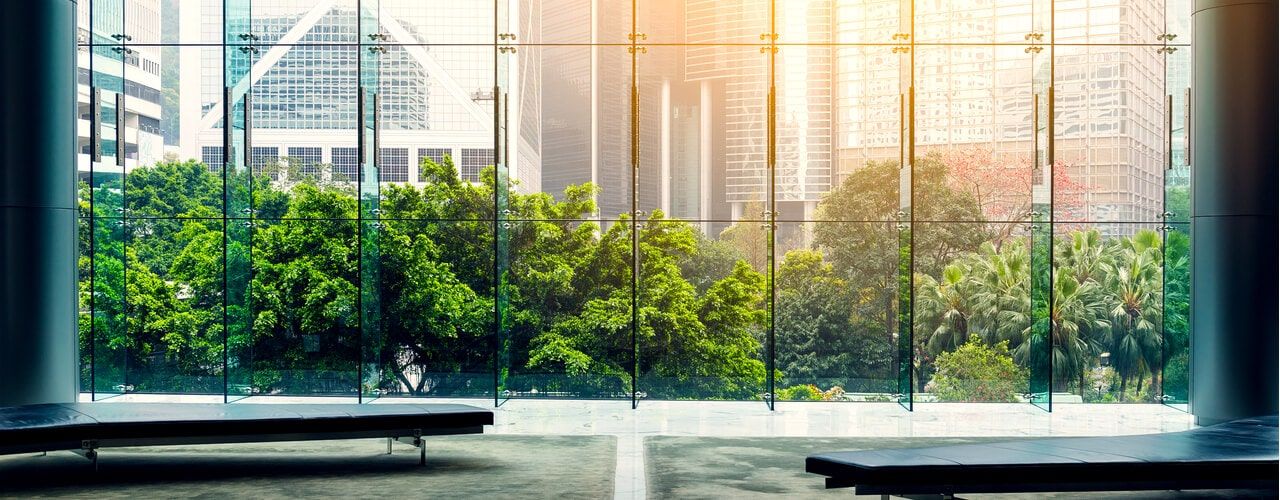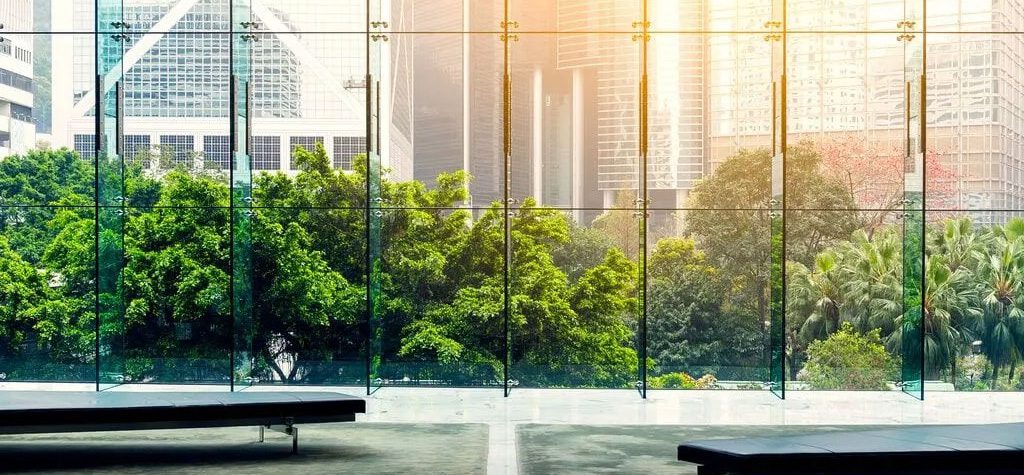The conversation around sustainability is constantly accelerating. People are increasingly concerned about being environmentally friendly, and businesses across all sectors are taking action to decrease the impact they have on the planet.
There’s lots of good sustainable practice occurring in the flexible workspace sector, too, but, as always, we can do more. This is especially true given that the built environment generates nearly 50% of annual global CO2 emissions, with 27% of those emissions coming from operations rather than construction.
If you’re looking for a way to make your workspace less wasteful and minimise its environmental impact, read on to find out what you can do about it. We’ve put together a list of 12 strategies you can consider implementing in your workspace to improve its sustainability credentials.
We’re not sustainability experts, so treat these recommendations as a starting point to move forward. When you come to implementing new sustainability features or practices, it’s always recommended to seek further support or direction from specialist organisations.


Research built environment sustainability organisations
There are a range of organisations in the UK that specialise in built environment sustainability, but two, in particular, are worth looking into as you begin to explore ways to make your workspace more sustainable.
The first is the Better Buildings Partnership, a collaboration project from some of the UK’s leading commercial property owners who work together to improve the sustainability of existing commercial building stock. Their website has plenty of resources and toolkits that can help you to understand sustainability in the built environment. Seeing examples of how other building owners have prioritised sustainability can be a massive help as you develop your own strategy.
Secondly, you can visit the UK Green Building Council (UKGBC). A registered charity with over 600 member organisations, UKGBC represents the voice of the built environment sectors’ current and future leaders who are striving for change. Their website features a solutions library full of useful resources to draw from, as well as courses and events that can boost your knowledge of cutting-edge sustainability practices.
Conduct an energy assessment
Energy consumption will play a big part in how well you’re able to meet your established sustainability goals. Before you can make improvements, you need to understand your current usage. An energy assessment can give you lots of information in this regard, providing an overview of how much energy your workspace currently uses and where usage can be optimised. NABERS Energy is a specialised energy assessment provider focusing on office buildings in the UK. Their ratings are based on benchmarks developed using real data and give you an idea of how your workspace compares to similar buildings elsewhere.
Enable sustainable transport
Domestic transport was responsible for 27% of the UK’s total CO2 emissions in 2019, highlighting how important sustainable transport options are to a broader flexible workspace sustainability plan. Location is a key factor here, with buildings that are closer to major public transport hubs being much easier to reach without the use of high-emission personal transportation. No matter where you are, though, there are several features to consider implementing to encourage sustainable transportation. Electric charging points for electric vehicles, bicycle storage, and on-site showers are three of the big ones.
Integrate renewable energy sources
There are also lots of things you can do to improve the way you source and use energy. The choice of renewable (or ‘green’) energy suppliers and tariffs seems to grow each year, giving you more chances to find one that suits your needs. These suppliers can supply your electricity needs with energy that is from up to 100% renewable sources with specific Power Purchasing Agreements enabling confidence that your energy really is clean. This would significantly decrease your workspace’s carbon footprint. You can also look into generating your own energy through solar panels, which is increasingly viable.
Optimise your air-conditioning/heating
Air conditioning units can use up to 41 kWh/m2, making them a significant source of energy use and expense! Upgrading to a new air conditioning unit is a way of bringing this figure down, as modern units tend to be much more energy efficient than older models. This is especially valuable for larger workspaces, with square metreage in the hundreds. The same is true of heating systems, too. In older buildings, replacing oil or gas heating with a more efficient system (such as air-sourced heat pumps) can bring about large sustainability improvements.
Implement green leases
Not so much a suggestion for operators leasing their workspace from a landlord as one for landlords looking to improve the sustainability credentials of the buildings they lease to operators, green leases are an emerging trend that can encourage your tenants to take responsibility. A green lease will typically include clauses that cover requirements for energy efficiency measures, waste management, and water efficiency in the use of the building, as well as restrictions on materials for fit-out and sourcing of FFE. They’re an effective, proactive way of ensuring that your property portfolio isn’t a drain on the environment.
A similar analogue if you’re a flexible office operator looking for a way to be more conscious about who uses your space is to adopt a positioning strategy that’s related to sustainability. Reflected in both your workspace (through implementing features listed here) and your brand (by talking about sustainability across your marketing channels), this positioning strategy can help to attract the ‘right’ occupiers who take sustainability seriously.
Carefully choose materials and equipment
Materials and equipment are in no short supply in a flexible workspace, so they present a great opportunity to optimise your sustainability credentials. If you’re pre-build or fit-out, consider prioritising sustainable materials in construction and interior decoration, such as wood from sustainable forestry. In terms of equipment, pay close attention to the energy efficiency ratings of every appliance and piece of technology you install and consider making the switch to LED lighting. Each will only make a small difference alone, but together they can contribute to a significant impact.
Incorporate a recycling/food waste scheme
Food and plastic waste are both large detractors to the environment. The former involves significant wasted energy use in producing and distributing food. The latter is damaging for more direct environmental reasons due to the required extraction of fossil fuels to produce plastic and its non-biodegradability, causing secondary impacts on the natural environment.
In 2021 the not-for-profit resources organisation, WRAP, stated that an estimated 1.2Mt (megatonnes) of the UK’s plastic packaging was recycled in 2020, and there were 9.5 million tonnes of food waste in the UK in 2018 alone. These stats show a big opportunity for improvement. As a flexible workspace operator looking to improve sustainability, take the 7 Rs (reduce, recycle, reuse, rethink, repair, refuse) seriously.
In particular, focus on implementing a simple and easy-to-use recycling system that covers:
- Minimising paper waste
- Composting food waste
- Consider banning single-use plastics
- Recycling plastic and glass
- Disposing of electronics responsibly
Ethically source consumables
If you provide tea, coffee, sugar, or other consumables in your workspace, trace where they’re being sourced from. Fairtrade produce is demonstrably environmentally-friendly, so if you can replace your current providers with Fairtrade ones, you’ll boost your sustainability credentials (and probably get better products in the process!). If you have a café on-site, consider their products as well. You can even go a step further and try to promote broader cultural change aimed at decreasing environmental impact by encouraging meat-free days.
Integrate green spaces
Although only a drop in the ocean on a planetary scale, think about where you can integrate plant life and other greenery. There are lots of options for doing this now, including green walls, roof terrace gardens, and indoor plants. Greenery in and around the workspace won’t just filter CO2 from the air, it’s also proven to help reduce stress, increase productivity, and reduce sickness. Not a bad reward from investing in a few plants!
Don’t overlook biodiversity
Even if your workspace doesn’t have any green spaces, it doesn’t mean that you should overlook biodiversity. Ecological surveys can be a key tool in understanding the biodiversity risk as well as seek out opportunities to enhance the biodiversity of your building. You can use resources from the Better Buildings Partnership to identify the correct survey that you need and then create a biodiversity action plan for your property manager to monitor and maintain.
Write a CSR policy
To capture your other ESG responsibilities, it is also essential to define your Corporate Social Responsibility (CSR) policy. This formal document will incorporate your intended approach to how your business will guarantee that all activities will be in-line with ethical, social, and environmental goals. Writing a CSR policy might seem intimidating to approach if you’ve never produced one before, so use a guide to help get you started.

